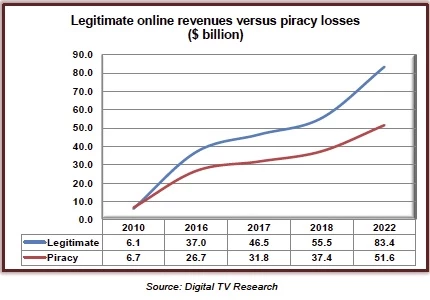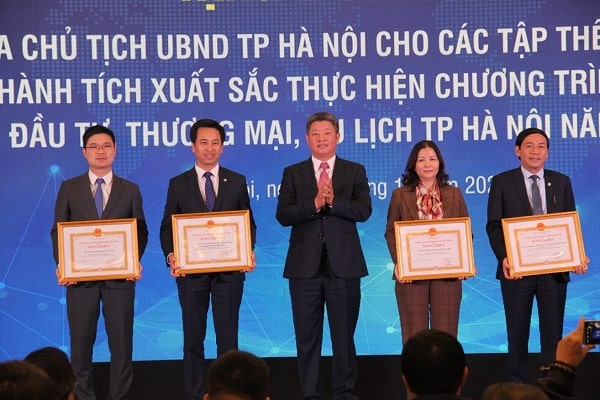Economic perspectives on copyright-based industries
VINASME organized the signing ceremony of emulation covenant in 2020 / Prime Minister: We must have an effective solution to remove difficulties for businesses
The Digital Content Industry is being evaluated as a "new gold mine" that is setting up a new multi-billion-dollar industry in Vietnam. The Internet has become the dominant platform for providing digital content such as movies, music, books, news, and software. Vietnam Enterprise Magazine is now publishing a series of articles written by Nguyen Ngoc Han (CEO Thudo Multimedia) from the perspective of "copyright management and protection on the Internet". Throughout the articles, it will manifest the importance of copyright as an incentive mechanism for the establishment and dissemination of digital content.

Copyrights is granted automatically and it does not require any official certification
Copyright is a form of Intellectual Property Right (IPR) that grants the authors of an original work (creative work) certain rights over that work for a limited period. The copyright holders own an exclusive tool to (1) duplicate their works in forms such as print publications or phonograms, (2) distribute copies or translations, (3) release the work or make it available, (4) license and/or lend it, (5) derive it (for example, to turn a book into a screenplay) or create a performance based on their work.
Independent of economic rights, authors are granted moral rights, copyright, right of integrity, right to attribution, and right to promulgate. These rights are remained with the authors even after the authors have transferred their economic rights to a third party (semi-exclusive).
Under the national copyright laws, these are the types of works that are protected: literary works (such as novels, short stories, poems, etc.), musical composition, works of art (two-dimensional drawings, paintings, or three-dimensional works such as sculptures, architectural works), maps and technical illustration (including cartographic works, plans, blueprints, diagrams, etc.), photographic works, cinematographic works, computer programs and creative works for databases. Copyright does not cover ideas, procedures, operational methods (know-how), or mathematical concepts.
Copyright protection is time-bound. According to the Trade-Related Aspects of Intellectual Property Rights (TRIPS) administered by the World Trade Organization (WTO), it specifies that copyright exists a minimum of 50 years after the author's death. There is a tendency for countries to adopt longer terms than the minimum required by TRIPS and international treaties administered by the World Intellectual Property Organization (WIPO). For example, the age of the author plus 70 years, or at least 70 years from the first publication if the author is not a natural person (Some data collected from satellites, time sensors, etc.) weather, geological exploration, etc.)
Copyright law has been partially standardized through a set of international conventions. The Berne Convention was one of the first international agreements on copyright, accepted in 1886. Most of the provisions from the Berne Convention were incorporated into the 1995 World Trade Organization's TRIPS agreement.
Nowadays, most countries apply the Berne Convention standards. Accordingly, copyright is granted automatically and does not require any formal certification in the context of a qualifying work is presented to the public in physical form or secured on media (Example: optical discs, computer files, paintings, etc.), the authors automatically get their exclusive copyright. Both the Berne Convention and TRIPS prohibit signatories from maintaining any procedures for the protection of copyrights.
In this context it should be also highlighted that what is “transacted” in copyrights is the right to access the intellectual property concerned, not the right to own the property itself. In other words, copyright is distinct from the means of delivery. A song is protected by copyright, but a music CD is a means of delivery. If you buy a music CD, you own that CD but you do not own the songs on it. What one gains under a copyright transaction, therefore, is the use of the work for certain purposes or for a particular length of time.
Economic rationale for copyrights
Before discussing the economic rationale for copyright, it is important to recall two key economic properties of creative works that make them fundamentally different from tangible goods. Specifically, creative works such as movies, books and musical compositions are non-rival and non-excludable.
They are non-rival, which means that they can be used by many persons at the same time without the individual value of consumption being reduced.
They are also non-excludable, which means that without appropriate legal rights it is usually very difficult for the authors to prevent unauthorised uses of the content (Watt, 2004).
These economic characteristics of creative works lead to some special features of markets for creative content. The non-rivalry of creative works, and the very low marginal cost of reproduction of most copyrightable property, especially in the digital era, means that without legal copyright protection the work would likely not exist (since a price close to marginal cost may not generate sufficient revenues to cover the fixed costs of creation).
The “non-excludable” feature refers to the economic role of legal rights and appropriate safeguards. The economic rationale for copyright is that without this protection, others can freely use it, infringing on the efforts of the author (creator of the original work) and thus impeding the provide original creative works.
Accordingly, the lack of sufficient, well-established and properly enforced copyrights would discourage future investments in new literary, artistic and creative works. This clear economic rationale for copyright is well reflected in law with the support of technical measures. For example: DRM Tool - to prevent easy copying and distribution of any original work such as books, movies, musical works, or literary works because “an original book, film, music composition or any other literary and artistic work is difficult to create but easy to copy” (Raustiala and Sprigman, 2006).
Thus the argument for copyright is that an incentive to create and disseminate must be fostered by giving the creator some control over how the creation can be used by others (Greenhalgh and Rogers, 2010). Authorial control through exclusive rights provides important economic incentives and gives the authors the possibility to make a living from their creative works. This in turn allows culture and creators to mutually flourish.

The role of laws and Digital Rights Managements (DRM) solution
The economic literature identifies an important trade-off related to copyright law: the balance between two different effects that emerge when the cumulative aspect of creation is taken into account. On the one hand, society needs enough protection so that, at any given moment of time, creative activities are undertaken. On the other hand, excessive protection could create market power and thus higher access prices, which would reduce the extent to which creative works are disseminated.
As Landes and Posner (1989) summarize: Copyright protection - the right of the copyright owner that is preventing others from making copies, using cheap copies leads to users refusing to use their original work, against incentives to create original work. Therefore, striking the correct balance between access and preference is central to copyright law.
To solve this problem, the flexibility of using technology solutions in the field of copyright, centered on DRM solutions for areas such as cinema, electronic publishing, art design, graphic design... is more effectively functional than legal-based institutions.
Thanks to the digital copyright protections, the authors now may have the flexibility to grant rights to consumers (consumers can use the work for free, but not copy), allowing authorized agent to distribute their works and rights and publicly calculate the number of uses of their works.
Also thanks to the DRM tool, the researches of organizations in the world (such as EPO-OHIM, 2013; ESA-USPTO, 2010; Japan Copyright Institute, 2009; Siwek-IIPA, 2004; Ministry of Culture), Media and Sport UK, 2014) has obtained good and much-needed copyright statistics to promote economic research in the field and provide viable and viable guidance for policymakers (Watt, 2004; Png, 2006; Handke, 2012).
Copyright-intensive industries There is a distinguished history in studies that have sought to assess the importance of industries reliant on copyright. The challenge to date has been to agree on which industries or which portion of industries should be considered ‘copyright industries’. In practice, this has been a function of the industries that supply work that is copyright protected and the available statistical data. Creative work that is subject to copyright protection, as defined by TRIPS, is produced in various parts of the economy. To facilitate the quantitative analysis of copyright-related activities in the economy, WIPO (2003) introduced a methodology that distinguishes copyright-intensive industries and divides them into four main groups: i) core, ii) interdependent, iii) partial, and iv) non-dedicated support. i)The core copyright-intensive industriesare industries that are wholly engaged in creating, producing and manufacturing, performing, broadcasting, communicating and exhibiting, or distributing and selling works and other protected subject matter. WIPO identified the following nine groups as core copyright industries: 1. Press and literature music
2. Theatrical productions 3. Operas motion picture and video 4. Radio and television 5. Photography 6. Software and databases
7. Visual and graphic arts 8. Advertising services 9. Copyright collective management societies In addition to the core copyright industries, WIPO also defines three groups of industries whose activity is related to copyright industries to some degree: interdependent, partial, and non-dedicated support industries. ii)Interdependent copyright industriesare industries that are engaged in production, manufacture and sale of equipment whose function is wholly or primarily to facilitate the creation, production or use of works and other protected subject matter.
iii)Partial copyright industriesare industries in which a portion of the activities is related to works and other protected subject matter and may involve creation, production and manufacturing, performance, broadcast, communication and exhibition or distribution and sales. iv)Non-dedicated support industriesare industries in which a portion of the activities is related to facilitating broadcast, communication, distribution or sales of works and other protected subject matter, and whose activities have not been included in the core copyright industries. Because interdependent, partial, and non-dedicated support industries are only partly engaged in copyright-related activities, only part of their employment and value added should be considered as copyright-intensive. To our knowledge there is no internationally agreed methodology for such exercise. Therefore, this report focuses only on WIPO’s “core” copyright industries (Gantchev, 2004). |
End of content
Không có tin nào tiếp theo
